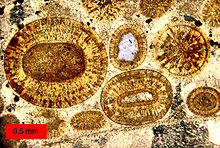Our website is made possible by displaying online advertisements to our visitors.
Please consider supporting us by disabling your ad blocker.
Ooid
This article includes a list of references, related reading, or external links, but its sources remain unclear because it lacks inline citations. (June 2014) |



Ooids (/ˈoʊˌɔɪd/,[1] from Ancient Greek ᾠόν (ōión) 'egg stone')[2] are small (commonly ≤2 mm in diameter), spheroidal, "coated" (layered) sedimentary grains, usually composed of calcium carbonate, but sometimes made up of iron- or phosphate-based minerals. Ooids usually form on the sea floor, most commonly in shallow tropical seas (around the Bahamas, for example, or in the Persian Gulf). After being buried under additional sediment, these ooid grains can be cemented together to form a sedimentary rock called an oolite. Oolites usually consist of calcium carbonate; these belong to the limestone rock family. Pisoids are similar to ooids, but are larger than 2 mm in diameter, often considerably larger, as with the pisoids in the hot springs at Carlsbad (Karlovy Vary) in the Czech Republic.
- ^ "Definition of OOID". www.merriam-webster.com. Retrieved 2024-08-19.
- ^ A to Z of Rocks, Minerals and Gems. Quarto Publishing Group UK. 2020. ISBN 978-0-7112-5684-2.
Previous Page Next Page


